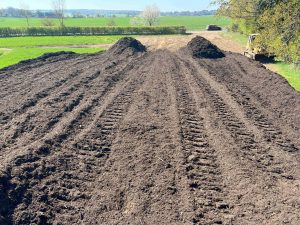Some of the local community have asked about the enormous mound of “soil” we have been building up on Swangleys Lane next to Baines Spring – the small wood near Baines Lane.

This mound forms an important part of Swangleys’ move towards more sustainable farming practises. We already carry out numerous environmental initiatives – many local people will be familiar with the km’s of hedging we have planted, the dozens of trees, the bird seed borders to some fields etc but possibly less aware of other initiatives such as skylark plots. Most people will not be aware that we have already moved from habitual full ploughing to what is known as “min till” where – in order to preserve the soil microbiome and structure – ploughing is largely replaced with a less invasive cultivation.
This spring we are introducing a very significant programme – the start of a move away from total reliance on artificial fertiliser. Crop-growing land needs fertiliser, but the normal agricultural source is artificial fertiliser made from gas (which is an oil industry product) and mined mineral rocks and therefore carries a high carbon footprint and so, in the long term, is unsustainable. It is not viable at this time for Swangleys to entirely move away from artificial fertiliser, but we are taking a very significant step this year.
The mound of “soil” on Swangleys Lane is entirely comprised of natural compost which has been made out of the contents of people’s brown bins. After collection, your brown bin garden waste is sorted, cleaned, chopped and then naturally composted over the course of a number of months. By the end of that process, compost can be spread on fields to not only replace artificial fertilisers and therefore dramatically reduce our carbon footprint but also increases the organic matter in the soils and encourages the vital microfauna to flourish.
This type of compost is not without its issues for us and we will also need to alternate it with other sources of natural fertiliser in order to provide the soil with what it needs, but it is a big step for us and we will be monitoring the results closely.
So, to answer the question that we have been asked, the pile of material on Swangleys Lane is approximately 1,200 tonnes of a total of 2,200 tonnes of natural matter that we will be bringing to Swangleys this spring and integrating into the soil.